What Happened in Charlottesville?
Gregory Hood, American Renaissance, December 4, 2017
The law firm of Hunton & Williams has just issued an independent, 207-page report on the Unite the Right protest that took place in Charlottesville last August. The city of Charlottesville commissioned and paid for the report, but it is no cover up. It is a slashing indictment of the way the city prepared for and handled the demonstrations. It is a thorough vindication of the perspective of the Unite the Right demonstrators.
The report makes clear that the Charlottesville Police Department (CPD) and its black chief, Al Thomas, had no intention of allowing the demonstration to take place. Astonishingly, the report leaves no doubt that Chief Thomas wanted the police to let enough violence go unchecked to justify an order to declare the event an “unlawful assembly” and shut it down. The report is also unflinching in its condemnation of police and city-administration bungling that virtually guaranteed continued violence even after the event was canceled.
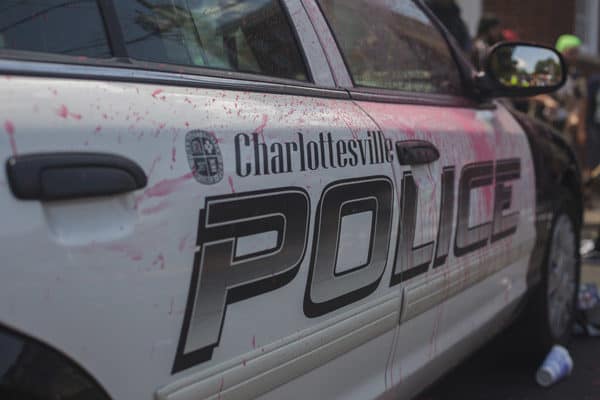
A Charlottesville police cruiser was paint bombed on August 12, 2017 in Charlottesville, Virginia, USA. (Credit Image: © Shay Horse/NurPhoto via ZUMA Press)
The report notes that from the very beginning, “in the face of strong community opposition to the Unite the Right rally, City leaders wanted to deny [rally organizer Jason] Kessler’s permit application.” “City Councilors responded to this pressure by injecting themselves into the operational details of the City’s response to the event — a function typically reserved for City staff.” (page 4) Just days before the event, the city tried to move the location for the rally, an attempt even the city’s own lawyers said was likely to be futile. A court overruled this transparent attempt to divert the rally and the only result was that uncertainty about the rally’s location had “a negative impact on preparations for this challenging event.”
Simple incompetence explains much of CPD’s failure. The report cites a “flawed Operational Plan,” poor coordination with the Virginia State Police (VSP), and no unified command structure. Chief Thomas technically had authority over both agencies for the protest, but failed to exercise it. Officers did not have riot equipment they needed, and VSP and CPD could not even talk to each other on the radio.
One of the most elementary rules of police control in situations like this is to keep hostile groups apart. There were several routes in and out of the park, so it was obvious where Unite the Right demonstrators and antifa counter-demonstrators were likely to meet if not separated.
The report notes that in a breathtaking display of poor planning, “officers were not stationed along routes of ingress and egress to and from Emancipation Park but rather remained behind barricades in relatively empty zones within the park and around the Command Center.” (page 5) Police were ordered not to stop street brawling unless it seemed that death or serious injury was imminent. Only once did officers leave their barricades to deescalate a potentially deadly confrontation (128). The role of the police was not to protect property and keep the peace. “Instead,” notes the report, “command staff prepared to declare an unlawful assembly and disperse the crowd.” (6)
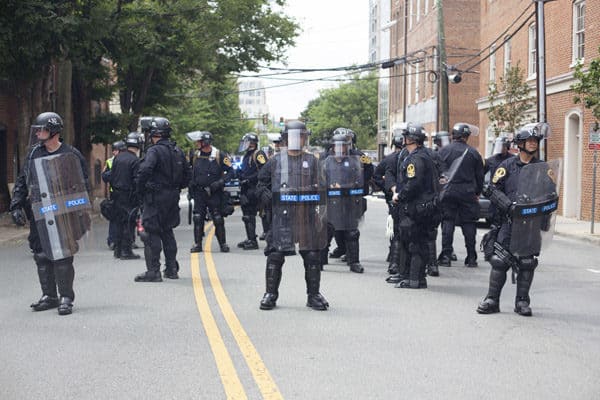
Virginia State Police patrolling the streets of Charlottesville on August 12, 2017. (Credit Image: © Shay Horse/NurPhoto via ZUMA Press)
Unite the Right militia groups did a better job than the police of separating warring factions. The report quotes a conversation between officers: “I like those militia guys.” “Yeah, they’re doing a good job.” (128) There is no excuse for an ad-hoc private group to do a better policing job than the police themselves.
The authors of the report are clearly baffled by the extraordinary levels of incompetence and inactivity of the police. They note that officers knew demonstrators would need secure routes, free from counter-demonstrators, into and out of Emancipation Park. They also knew what routes the demonstrators would take and that they planned to use shuttle buses. Thus, there was a plan to man the obvious entrance and exit routes so that demonstrators would not have to run a gauntlet of counter-demonstrators: “In one version, planners considered assigning as many as thirty officers to Market Street south of Emancipation Park and twenty officers along 1st and 2nd Streets north of the park. When asked why this plan was abandoned, no one on the CPD command staff could provide a specific answer.” (93)
It will probably take litigation to determine why this sensible plan was abandoned. We can only assume that the goal was to stage a confrontation that would create enough chaos to justify stopping the rally. “Rather than engage the crowd and prevent fights, the CPD plan was to declare the event unlawful and disperse the crowd,” the report notes. “The Operational Plan outlined the steps by which an unlawful assembly could be declared.” (98)
The counter-demonstrators therefore played a key role. Seth Wispelwey is a cleric involved in a group called “Congregate Charlottesville” that organized training sessions to “delay and obstruct the hate-speech that they expected.” Activists who attended the trainings “were willing to break the law.” (72) Mr. Wespelwey told the report’s authors his group “intended to block entry for the Unite the Right demonstrators,” an act which would hopefully ” ‘create a scene’ that would lead to a police response.” (129)
Accordingly, “clergy” working with antifa blocked the routes for demonstrators to attend their legally sanctioned rally. Leftists barred the way against a column of the League of the South and the Traditionalist Workers Party and were, as police noted, “trying to take over the street.” Although police could tell things were going to get “ugly,” they took no action to clear the street and let the demonstrators pass. The demonstrators were forced to walk through the ranks of screaming counter-demonstrators, while police looked on. (130) Violence was inevitable — violence that could have been prevented by establishing safe routes in and out of the park. The report includes an illuminating exchange:
At 10:45 a.m., a man with an American flag approached officers in Zone 1 and asked, “What’s a good way to get into the park?” An officer responded, “Right now, there is no good way.” Another officer suggested that “up the front” would be easiest. The man pointed at the clergy blocking the southeast staircase and asked, “Through that?” The officer responded, “That’s the only way.” The man walked away. One officer turned to his colleague and said, “Welcome to Charlottesville.” (130)
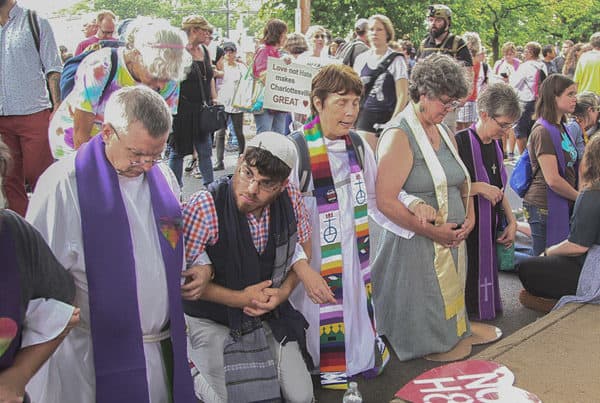
Protesters pray during the Unite the Right free speech rally at Emancipation Park in Charlottesville, Virginia, on August 12, 2017. (Credit Image: © Emily Molli/NurPhoto via ZUMA Press)
It is worth recalling that the demonstrators had a permit to hold a legal rally. It was the duty of the police to stop anyone from interfering; they obviously failed in their duty. Violence was inevitable.
One of the most astonishing passages of the report quotes officers who heard CPD Chief Thomas say: “Let them fight, it will make it easier to declare an unlawful assembly.” (133) Sure enough, the violence on Market Street gave the police the justification they thought they needed to declare an unlawful assembly even before the rally began. Then — finally — officers went into action to disperse the demonstrators.
But dispersing the demonstrators meant driving them into screaming antifa protesters, an action that one officer called the “most messed up thing I ever saw.” (135) Police also used pepper spray to drive the demonstrators out of the park, so instead of dispersing the crowd in an orderly way or separating demonstrators from counter-demonstrators, the police ensured a chaotic, sprawling brawl.
Alt-Right demonstrators, caught between police threats and the clubs of the antifa mob, screamed to the police that they were delivering them into the hands of their enemies. Instead of making even a token gesture to protect the demonstrators they were dispersing, the CPD remained concentrated in an empty area of Emancipation Park. The report notes that these terrible tactics were a source of frustration for the officers themselves. (135)
At this point, “violence broke out in all directions.” (136) There were no officers stationed anywhere along the exit routes. The result was not just one confrontation, but many confrontations, as protesters and counter-protesters fought running battles. The report confirms that a black man, Deandre Harris, attacked demonstrators with a club or flashlight. When demonstrators defended themselves, their action was caught on video and widely portrayed as a “racist” assault on an innocent black man. Mr. Harris raised many thousands of dollars and is currently being represented by former New Black Panther Party head Malik Zulu Shabazz.
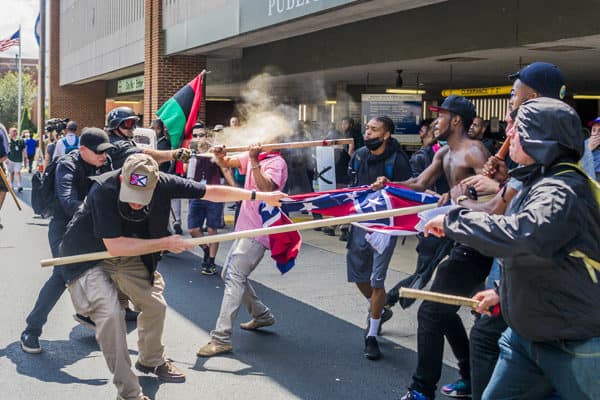
(Credit Image: © Michael Nigro/Pacific Press via ZUMA Wire)
Antifa were not content simply to disengage from violence. They attacked one militia group that simply wanted to get away. The report notes what happened when the militia finally reached their cars:
The militia got in their cars and prepared to leave the area. Aerial footage shows that one of their cars accelerated to flee the counter-protesters, nearly running one of them over. The crowd of counter-protesters reacted angrily, kicking and swinging objects at the car. The car sped around South Street, then 2nd Street, then west on Water Street, with counter-protesters chasing on foot. (141)
As the report notes, there was more chaos:
Unbeknownst to the police, the counter-protesters who had followed the militia across the parking lot believed [falsely] that they were intentionally headed towards Friendship Court to harass residents [most of whom are black]. The call went out through their communications channels that Friendship Court was under attack. Large groups at Justice and McGuffey Parks began to mobilize. (142)
Hundreds of people gathered to defend a completely imaginary “racist” threat. It was in this context that Heather Heyer died. The report says Miss Heyer was “fatally struck” by James Field’s vehicle, contradicting some reports that say she died of a heart attack. Otherwise, the report offers no new information: nothing about James Field’s movements before the fatal collision, no information about whether antifa were attacking cars, and no details about Mr. Field’s intentions or what may have caused the incident.
However, the report does note something very important. A “school resource” officer — someone whose job is to police school children — had been assigned to prevent cars from going down 4th street toward the demonstration area, the very area where Heather Heyer was killed. The officer, Tammy Shifett, was a woman who had been off work for most of the previous two months recovering from elbow surgery — not someone likely to be capable of forceful law enforcement. Hours after the demonstration had been dispersed, there were hundreds of people still milling around the area. The report says that:
This officer feared for her safety as groups of angry Alt-Right protesters and counter-protesters streamed by her as they left Emancipation Park. The officer called for assistance and was relieved of her post. Unfortunately, CPD commanders did not replace her or make other arrangements to prevent traffic from traveling across the Downtown Mall on 4th Street. A single wooden saw horse was all that impeded traffic down 4th Street as large groups of people continued to roam the streets. This vulnerability was exposed when James Fields drove his vehicle down the unprotected street into a large crowd of counter-protesters at the intersection of 4th Street SE and Water Street, killing Ms. Heyer.
Press and video reports seem to show — at least by the time Heyer died — that the area was not full of “angry Alt-Right protesters and counter-protesters” but only counter-protesters. In any case, for the situation to have been so menacing that an officer fled for her life — and the CPD simply abandoned the position — is a devastating indictment of police tactics.
The report’s recommendations are largely sound, including improved training and communications and the obvious: “enforced separation of protesters and counter-protesters.” (171) The report also notes, appropriately, that the city is “legally obligated” to enforce the right of free speech for anyone, regardless of how many people disagree. The report further states the obvious: “Law enforcement should not plan to declare an event unlawful and disperse crowds before an event begins or permit violence that is likely to disrupt a planned event.” (170)
The report also calls on the Virginia General Assembly to pass a law that would “criminalize the use of a flame to intimidate.” (8) This happened when a black counter-protester used a homemade flamethrower to attack Unite the Right demonstrators being driven into the streets by police. One recommendation, however, is questionable: “[R]equire permits for all events involving open flames.” (8) This is an obvious reference to the Tiki Torch march on the night of August 11, but a torchlight parade is a recognized protest tactic around the world.
The report issues several vague recommendations for more “citizen feedback,” including a call for “diverse working groups” to provide guidance on issues facing the city. At this point, the city of Charlottesville can’t even hold a city council meeting with getting “feedback” in the form of rowdy protesters. And, as the report admits, “anti-racist” groups don’t want to work with the city or the police:
Community skepticism of City government handicapped our ability to gather facts and develop relevant information. Representatives of various anti-racist groups told us that our attorney-client relationship with the City was the basis for their refusal to provide us with information. These individuals wanted us to keep information received confidential and not share it with the City, and they asked us to guarantee the public release of our full report. The distrust of City officials was palpable in our conversations with those groups.
We have also witnessed a lack of faith in City officials at City Council and other public meetings. Community criticism of the Charlottesville Police Department is particularly acute. Some of this skepticism is a reflection of the actions of CPD and other law enforcement agencies during these protest events. . . . Some people see those actions as part of a broader pattern of law enforcement inability or unwillingness to protect public safety, particularly in communities of color. Skepticism about CPD is also informed by concerns over racial profiling, drug enforcement, and other systemic issues beyond the protest events. (177)
The reason the “anti-racist” groups don’t want to speak to the police or even the authors of this report is that unlike the Unite the Right demonstrators, they planned illegal activities from the outset and see the police as their sworn enemies.
As for the demonstrators, the report notes again and again how open and communicative they were with law enforcement, both before and after the rally. This was to be expected. Well before the event, CPD contacted experienced police departments for advice and learned that “Alt-Right groups were generally cooperative with law enforcement” — though an officer from Portland thought that “members of the Alt-Right often attempt to ingratiate themselves with law enforcement” — whatever that means. (88) Police from other cities invariably warned Charlottesville to keep demonstrators and counter-demonstrators apart — commonsense advice Charlottesville failed to follow.
The relationship between law enforcement, the demonstrators, and the antifa is illustrated by an incident from the protest. When the Virginia State Police marched into Emancipation Park in riot gear, the Unite the Right demonstrators applauded them and chanted “Blue Lives Matter.” The demonstrators were then shocked when the VSP ordered them to disperse and pushed them into the arms of their enemies. The antifa then serenaded the officers with chants of “F**k the police.”
The report shows the demonstrators were fundamentally right in their assessment of the actions of the city government and the police. The report tries to be even-handed, but it fails to note that no special police presence would have been necessary at all, except for the presence of antifa and other counter-demonstrators whose sole purpose was to disrupt and, if possible, shut down the rally.
The most straightforward advice to Charlottesville is this: Defend free speech, and arrest those who break the law. Perhaps the most unwitting but eloquent symbol of the city’s failure to do so is the photo on the cover of the report itself. It is not even from the Unite the Right rally but from an earlier KKK rally. It shows a solitary black officer, his back to the demonstrators, hands clasped, looking like he’s asleep on his feet.
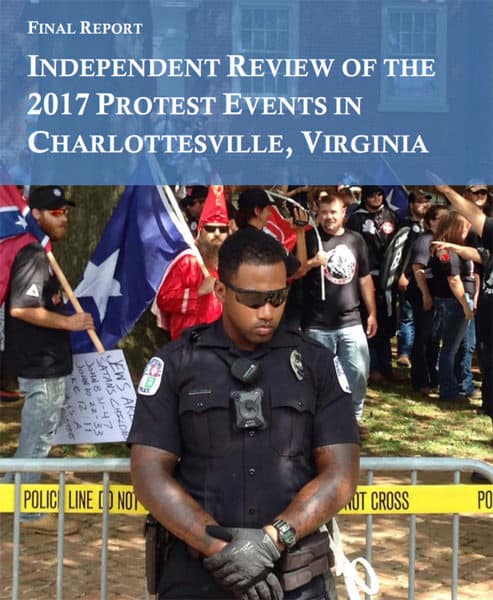
Photo credit: Jill Mumie















